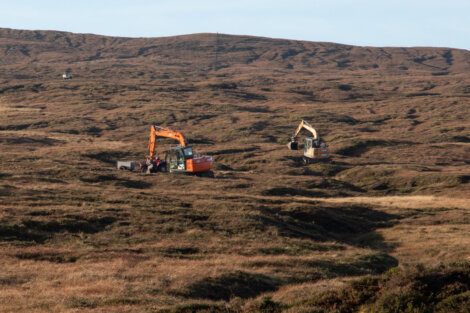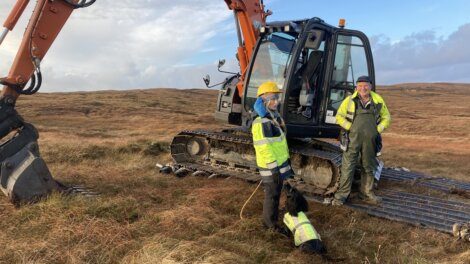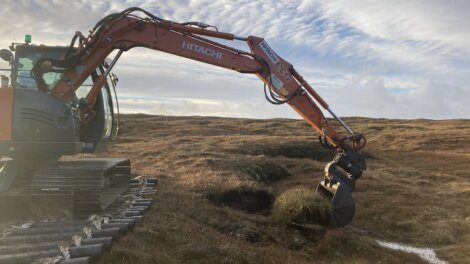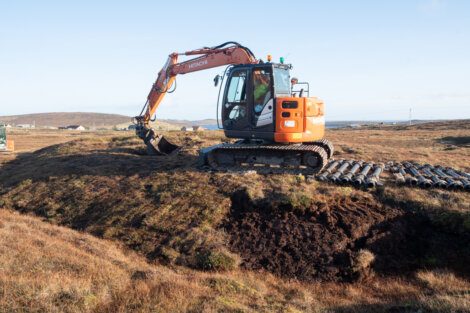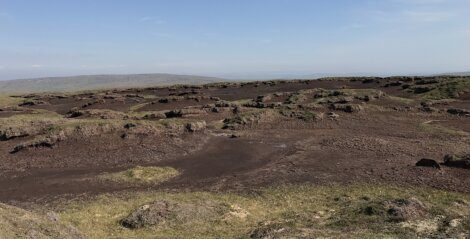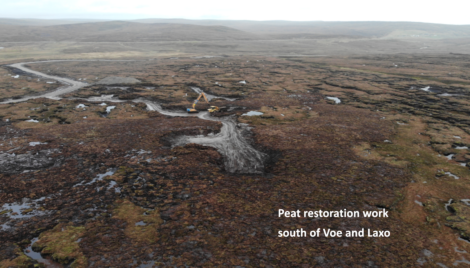Climate / Peatland restoration key to improving Shetland’s horrific carbon footprint
SHETLAND could reduce its carbon footprint by tens, if not hundreds of thousands of tonnes per year, by restoring the islands’ degraded peatlands.
The move is likely to have a more dramatic impact on reducing the release of CO2 and other climate changing gases than many of the industrial projects currently proposed or already underway.
It is also significantly cheaper to achieve big results in reducing Shetland’s climate impact and could – once restored and acting as a carbon sink again could – potentially become a big earner for crofters and landowners as part of a carbon offsetting scheme.
It is by now common knowledge that Shetland’s domestic carbon footprint at more than ten tonnes per person per year is the highest in the UK.
Add to that Shetland’s industrial footprint, the isles’ carbon emissions are in the region of 650,000 tonnes per annum as was suggested in a document recently published by the ORION clean energy project. That’s the domestic impact multiplied by three.
But it is only when adding the CO2 emissions from Shetland’s degraded peatlands, created through thousands of years of peat cutting and more recently overgrazing by sheep, that the real extent of the islands’ carbon footprint starts to become obvious: it is millions of tonnes and all projects underway are just scratching the surface.
During last week’s meeting of Shetland Islands Council’s transport and environment committee, consultants tasked to produce a net zero route map for Shetland presented a slide that should have raised a few eyebrows.
Become a supporter of Shetland News
According to Ricardo plc, a global environmental consultancy, 67 percent of Shetland’s CO2 emissions come from LULUCF – that’s from land use, land use change and forestry or, in other words, human impact on terrestrial carbon sinks, in Shetland’s case mainly peatlands, but also any other land use.
According to Sue White, Shetland Amenity Trust’s peatland action project officer, anything between four and 23.8 tonnes of carbon dioxide equivalent (CO2e) are emitted from degraded peatlands per hectare per year, and there are 40,000 hectares of it in Shetland alone.
With half of Shetland made up of peatlands and around 70 per cent of that blanket bog damaged – that’s according to NatureScot – White has the mammoth task of somehow organising the restoration of at least some of it while employed for just three days a week.
People regularly using the A970 near Girlsta will have asked themselves what the diggers are doing in the middle of the bog near the Stromfirth junction, also known as Taits Park.
White describes it as “light touch” peat restoration in action. Over coming months contractors from David Murray’s Shetland Peatland Restorations are filling in draining ditches to increase the water level in the moor, and are reprofiling bare peat faces and putting back vegetation to stop the loss of carbon.
Once the work is completed on the 66-hectare project site it will take about five years before the bog will act as a carbon sink once again.
If all the above figures are correct; then the restoration work at Taits Park could result in around 1,500 tonnes of CO2e emission savings annually; that’s roughly the same amount 650 average cars emit, driving each 10,000 miles a year.
That’s a significant saving and relatively easy to achieve and at comparatively low cost, White points out.
The average cost of restoring of peat restoration is between £3,000 and £5,000 per hectare depending on the topography and the state of the moor.
“It’s a learning process,” she says. “You have to sort out the hydrology first because blanket bog is a rainwater fed system and the rainwater should stay on the hill; if it is in a good state then 95 per cent of it is water.
“The vegetation knits in quickly and has usually grown within a year.”
Where there are larger areas of bare peatlands new techniques are being developed to stabilise the peat and prevent it from being washed (or blown) away by using salmon farm netting but also waste wool fibre from Jamieson’s spinning mill.
“The wool is full of peat, and full of seeds – it really works well,” she said, adding that she sees peatland restoration as a massive opportunity for the islands, one that should be shouted about much louder.
“Shetland could contribute something positive to the climate crisis.”
If Scotland wants to meet its ambitious climate target of being net-zero by 2045 then vast areas of degraded peatland, not only in Shetland, will have to be restored over the next 24 years.
The government has committed a ten-year, £250 million package to get this process under way. But to achieve this goal projects like the local peat restoration programme has to be stepped up by the factor ten.
In good years, White says, she and her team of contractors manage to restore 200 hectares, yet the task at hand in Shetland alone is to restore around 40,000 hectares; so peat restoration could well be the next big thing once the peat moving operation at the Viking Energy construction site has been completed and digger drivers are looking for the next job.
White is clearly not impressed by the ongoing peat restoration at the Viking site but says her approach has to be pragmatic. She has just been appointed to SWEAG, the Shetland Windfarm Environmental Advisory Group.
She describes a recent Viking site visit as “fascinating”, adding: “We are doing this with the lightest touch possible, Viking by contrast is completely different, it’s a construction site.”
Wind farm owner SSE Renewables is committed to restoring 260 hectares of eroded peatland as part of the construction work which also sees 69 kilometres of tracks being built within the central mainland site.
“At present, the peat generated by the excavation of tracks and turbine bases is being used to fill in bare, actively eroding areas, with the intention of halting the erosion process and the associated release of carbon,” a spokesperson said.
“Where possible, these areas are being turfed using vegetation from the site, though some areas will be seeded with species including those native to Shetland’s blanket bog. This will stabilise the peat surface and allow species such as sphagnum and cotton-grass to colonise naturally.
“Once construction is complete, the process of peatland restoration will continue, using more ‘traditional’ techniques, for example reprofiling peat hags (bare edges) and damming the gullies that guide water away from the blanket bog.”
Become a supporter of Shetland News
Shetland News is asking its many readers to consider start paying for their dose of the latest local news delivered straight to their PC, tablet or mobile phone.
Journalism comes at a price and because that price is not being paid in today’s rapidly changing media world, most publishers - national and local - struggle financially despite very healthy audience figures.
Most online publishers have started charging for access to their websites, others have chosen a different route. Shetland News currently has over 600 supporters who are all making small voluntary financial contributions. All funds go towards covering our cost and improving the service further.
Your contribution will ensure Shetland News can: -
- Bring you the headlines as they happen;
- Stay editorially independent;
- Give a voice to the community;
- Grow site traffic further;
- Research and publish more in-depth news, including more Shetland Lives features.
If you appreciate what we do and feel strongly about impartial local journalism, then please become a supporter of Shetland News by either making a single payment or monthly subscription.
Support us from as little as £3 per month – it only takes a minute to sign up. Thank you.



































